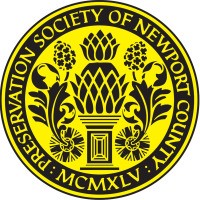Biographical/Historical Note
The King and Armstrong Families:
Ella Louisa Rives (b. 1851), daughter of Francis Robert and Matilda Barclay Rives and granddaughter of Virginia Senator William Cabell Rives, married David King Jr. in 1875. King was recently retired from the China Trade after amassing a reasonable fortune in the firms of Wetmore, Williams and Co., and Russell and Co. The couple spend winters at their townhouse in Washington, D.C. and on extented European holidays, while much of the late summer and autumn was spent at Kingscote, their summer cottage in Newport. The Kings' annual European holidays typically included shopping trips in Paris, where Ella purchased pieces from the fashion houses of Worth and Doucet in order to be properly attired for her diverse social obligations. Despite not being involved in business as such, the Kings nonetheless remained engaged in a number of scholarly, leisurely, and political pursuits. The couple had two children: Maud Gwendolen (simply known as "Gwendolen"), born on October 2, 1876; and Philip Wheaton Rives, born on June 5, 1878. Ella was widowed in 1894 when David King Jr. died suddenly of pertonitis following a brief bout of appendicitis. After his death she sold the Washington, D.C. townhouse and spent the rest of her life either at Kingscote or abroad in Europe.
Gwendolen's childhood consisted of a home education focused on literature, art, etiquette, French and German language, and violin lessons. In addition to this, she went on numerous hikes and nature walks as well as outings to museums. Her education was supplemented by a variety of leisure activities such as horseback riding, golf, tennis, beach outings and picnics, and as a child she traveled extensively with her parents. She debuted in society in 1896 after a delay due to the death of her father. Five years later, in 1901, she became engaged to Edward Maitland Armstrong.
Edward Maitland Armstrong was the son of David Maitland Armstrong, former diplomat to the Papal States (1869), American Consul in Rome (1869-71), and Consul General in Rome (1871-73). In 1878 he was appointed Director of American Fine Arts at that year's World's Fair in Paris. A painter himself, he came into conflict iwht the committee due to his desire to show younger and less well-established artists. During the 1880s he began working in stained glass with Louis C. Tiffany and John La Farge, and eventually formed his own firm Maitland Armstrong and Co. in 1887. The children of David Maitland Armstrong and his wife, Helen Neilson, would continue this artistic legacy. One daughter, Margaret Neilson, became a book designer, novelist, and biographer; another, Helen Maitland, followed her father into the stained glass business and became a prominent artist there herself. One of their sons, Hamilton "Ham" Fish, was the editor of the influential foreign policy journal "Foreign Affairs" from 1928 to 1972. Edward Maitland himself became a landscape architect at a firm in New York City.
Ella Rives King helped Gwendolen prepare her trousseau in Paris, and Gwendolen and Edward hwere married on September 12, 1901. After a honeymoon in Europe the couple settled down in the small country town of Babylon on Long Island. They would have three children: David King Maitland (1903), Edward Maitland Jr. (1905), and Gwendolen Ella (1911). In addition to often visiting New York City by train to lunck with friends, shop at department stores, visit museums, and attend concerts, Gwendolen spend much of her time engaged in community activties: founding a day school, joining a basketball league, volunteering with the local Red Cross, and organizing social outings.
By the turn of the 20th century the finances of both the King and Armstrong families had diminished. This was in large part due to industrial fortunes of the late 19th century overtaking and eventually superseding the "old money" of real estate and the China Trade. The Armstrongs were thus obliged to adopt a more modest lifestyle, which for Gwendolen meant no more annual trips to Paris. Ella Rives King, however, continued to visit Paris, often for the purpose of ordering European-made couture fashions. Unlike her daughter, she viewed department stores and ready-made clothing as convenient but ultimately beneath a woman of her station.
Gwendolen would spend much of her life at Kingscote, especially following the sudden death of her husband in 1915. During the 1950s and 1960s she resisted the efforts of the city of Newport to demolish Kingscote and build a modern high school on the property. She managed to prevent the building's destruction, and became an active supporter of the Preservation Society. After her death in 1968 the property passed to her daughter, Gwendolen Ella Armstrong Rives, who in turn bequeathed it to the Preservation Society upon her own death four years later.


